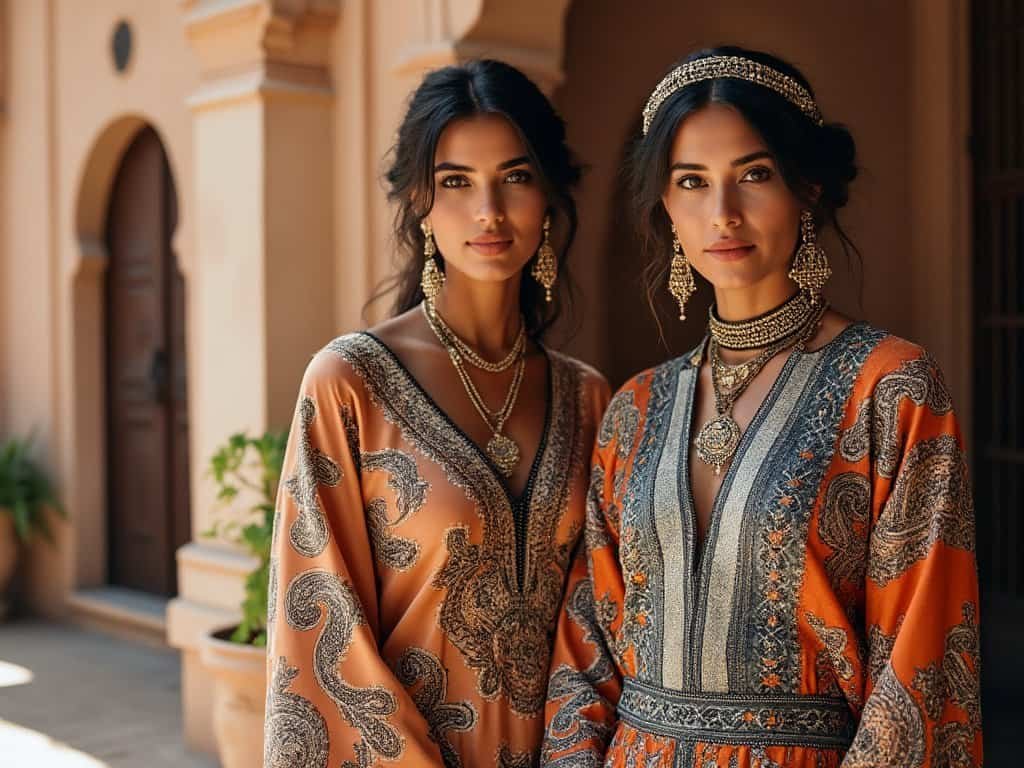Moroccan fashion has a rich heritage steeped in tradition, elegance, and cultural symbolism, with two of its most iconic garments being the Moroccan Kaftan and the Moroccan Takshita. While these garments share similarities, each holds its own place in Moroccan culture and fashion. In this post, we’ll explore the differences between the Moroccan kaftan and takshita, including their history, features, and unique characteristics.
1. Historical Background
- Moroccan Kaftan: Originating centuries ago, the kaftan is one of the oldest garments in Moroccan history. Its design was influenced by various cultures, including Persian, Ottoman, and Andalusian, and it became a symbol of nobility and status among Moroccan women.
- Moroccan Takshita: The takshita is a newer addition to Moroccan fashion, evolving as an elaborate two-piece variation of the kaftan. It reflects the influence of Moroccan royalty and is often worn for celebrations and important ceremonies, showcasing opulence and intricate craftsmanship.
2. Garment Structure
- Kaftan: The kaftan is typically a one-piece garment, often resembling a long, flowing robe. Made from luxurious fabrics, the kaftan is designed to be comfortable yet elegant and is usually worn as a single-layer dress, especially in traditional styles.
- Takshita: The takshita is distinguished by its two-piece structure. The first layer, called the “tahtia”, is a simple dress that provides a base. The second layer, known as the “dfina”, is an over-dress that features intricate embroidery, beadwork, and luxurious embellishments. The two layers are held together by a traditional belt, known as the “mdamma” or “hzam,” which adds definition to the waistline.
3. Style and Design
- Kaftan: Known for its simplicity and elegance, the Moroccan kaftan can be either modestly decorated or richly embroidered, depending on the occasion. Common designs include floral patterns, geometric shapes, and subtle sequins. Kaftans are often tailored with wide sleeves and may include intricate details along the neckline, sleeves, and hemline, emphasizing elegance without being overly ornate.
- Takshita: The takshita is inherently more elaborate, often decorated with lavish embroidery, sequins, and beadwork on the outer layer. The designs are intricate, and the garment itself is designed to make a statement, making it popular for weddings and formal events. Takshitas often feature brighter colors, metallic threads, and luxurious fabrics like silk, velvet, and satin.
4. Occasions and Usage
- Kaftan: Kaftans are versatile and can be worn at various events, from family gatherings and religious ceremonies to weddings. While a more elaborate kaftan might be chosen for a wedding or formal event, simpler kaftans are suitable for everyday wear or less formal gatherings, making it a staple in Moroccan wardrobes.
- Takshita: The takshita is reserved for very special occasions due to its intricate design and multiple layers. Brides often wear takshitas at Moroccan weddings, and they are a symbol of festivity and celebration, meant for high-profile events where glamour and traditional style take center stage.
5. Fabric and Materials
- Kaftan: Traditionally crafted from lightweight, luxurious fabrics like silk, chiffon, or fine cotton, kaftans are often chosen for comfort and breathability, especially in warmer climates. Embroidery on a kaftan tends to be more subtle, aligning with the garment’s understated elegance.
- Takshita: Takshitas use a combination of heavier and more structured fabrics, including velvet, brocade, and satin for the outer layer, which helps the dress maintain its shape and adds a luxurious look. The inner layer may be a lighter fabric to ensure comfort, while the belt is often adorned with jewels or metallic threads to highlight its formal, festive nature.
6. Cultural Significance and Symbolism
- Kaftan: The kaftan is a symbol of Moroccan heritage, pride, and modesty. It reflects the essence of Moroccan culture with its balance between elegance and tradition. While modern designers have introduced contemporary variations, the classic kaftan remains timeless.
- Takshita: The takshita symbolizes celebration and affluence. Worn primarily at weddings and major events, it showcases a sense of luxury and grandeur, marking the wearer as someone celebrating a significant life milestone. For many Moroccan brides, the takshita represents the cultural passage into marriage and adulthood.
7. Belt (Mdamma or Hzam)
- Kaftan: Some kaftans may be worn with a belt, but it’s typically simple and serves to enhance the garment’s silhouette rather than as a statement piece.
- Takshita: The belt on a takshita, however, is a defining feature. Often wide and highly decorated, it accentuates the waist and adds a distinct regal touch. It’s common for this belt to be crafted with ornate metalwork, jewels, or embroidery, underscoring the garment’s opulent appearance.
Choosing Between Kaftan and Takshita
For those looking to select between a kaftan and takshita, consider the following:
- Event: If the occasion is a wedding or large celebration, a takshita might be the better choice for its elaborate design. For a more relaxed or modest gathering, a kaftan offers elegance and comfort.
- Personal Style: Those who prefer simplicity may lean toward the kaftan, while the takshita is ideal for anyone who loves making a bold, sophisticated statement.
- Climate and Comfort: Kaftans are often lighter, making them ideal for warmer weather. Takshitas, with their heavier fabrics, can be more suitable for cooler settings or indoor, air-conditioned venues.
Conclusion
The Moroccan kaftan and Moroccan takshita are both exquisite garments that embody the elegance of Moroccan fashion, each serving unique purposes and styles. Whether you are attending a casual family gathering or a grand wedding, these garments provide versatile yet timeless options. Embracing either allows one to celebrate Moroccan culture while showcasing personal style through fashion steeped in tradition.
Explore more Moroccan kaftans and takshitas on KaftanKenza.com to find the perfect piece for any occasion!

